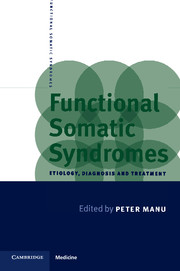Book contents
- Frontmatter
- Contents
- List of contributors
- Preface
- 1 Definition and Etiological Theories
- 2 Chronic Fatigue Syndrome
- 3 Fibromyalgia Syndrome
- 4 Irritable Bowel Syndrome
- 5 Premenstrual Syndrome
- 6 Interstitial Cystitis
- 7 Temporomandibular Disorders
- 8 Chest Pain Syndromes
- 9 Repetitive Strain Injury
- 10 Multiple Chemical Sensitivities
- 11 Psychopharmacology of Functional Somatic Syndromes
- 12 Psychotherapy of Functional Somatic Syndromes
- 13 Determination Of Disability Claimed By Patients With Functional Somatic Syndromes
- 14 Functional Somatic Syndromes: Exploring Common Denominators
- Index
9 - Repetitive Strain Injury
Published online by Cambridge University Press: 08 January 2010
- Frontmatter
- Contents
- List of contributors
- Preface
- 1 Definition and Etiological Theories
- 2 Chronic Fatigue Syndrome
- 3 Fibromyalgia Syndrome
- 4 Irritable Bowel Syndrome
- 5 Premenstrual Syndrome
- 6 Interstitial Cystitis
- 7 Temporomandibular Disorders
- 8 Chest Pain Syndromes
- 9 Repetitive Strain Injury
- 10 Multiple Chemical Sensitivities
- 11 Psychopharmacology of Functional Somatic Syndromes
- 12 Psychotherapy of Functional Somatic Syndromes
- 13 Determination Of Disability Claimed By Patients With Functional Somatic Syndromes
- 14 Functional Somatic Syndromes: Exploring Common Denominators
- Index
Summary
The term, repetitive (or repetition) strain injury (now often abbreviated to RSI), was first used in 1982 in a report from the Australian National Health and Medical Research Council and was widely reported in the Australian subcontinent. In the USA the term used for the same ‘disease’ is cumulative trauma disorder and the favored description in the UK is work-related upper limb disorder. The essential features of the disorder, injury caused by repetitive movements leading to strain of the musculo-ligamentous structures, is encapsulated in the words repetitive strain injury. The status of this disorder continues to arouse controversy because of the lack of objective findings in the sufferers from this condition and uncertainty about how far the disorder is work related (Tyrer, 1994a).
History
Work-related upper arm symptoms are not new. In 1713 Ramazzini described pain in the arms in scribes and notaries which he believed was due to the constant use of quill pens for writing, poor seating and excessive mental labor. The scribes were said to be worked hard by their masters, with few breaks so that they would not cause their master any financial loss. The features of repetitive activity, faulty posture during work and stress associated with the activity have been described by numerous authors subsequently.
Symptoms of pain and fatigue in the arms in writers in the British Civil Service were reported by Sir Charles Bell in 1833 and were thought to be due to the availability of steel-nibbed pens, which had been introduced in place of the quill variety (Bell, 1833).
Keywords
- Type
- Chapter
- Information
- Functional Somatic SyndromesEtiology, Diagnosis and Treatment, pp. 175 - 201Publisher: Cambridge University PressPrint publication year: 1998
- 1
- Cited by



